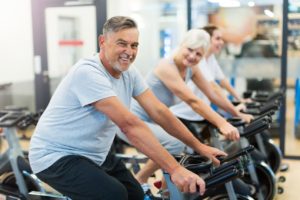
Osteoarthritis is the most quickly growing cause of disability in the world. Although it is more common in older adults, osteoarthritis can also affect Australia’s working age population i.e., those aged between 15-64 years. Osteoarthritis is commonly found in the hip and knee and can result in pain, impact on daily activities and reduce quality of life. It is important to note that the impact of osteoarthritis varies significantly between individuals. For some, it may cause mild discomfort, while others may experience more persistent, severe pain.
While you may worry that exercising with osteoarthritis could harm your joints and cause more pain, high quality research shows that people can, and should, exercise when they have osteoarthritis. In fact, current national and international clinical guidelines recommend education, exercise and weight loss as first line treatment for people with osteoarthritis.
Living with hip or knee osteoarthritis can be very challenging. That’s why the GLA:D® (Good Life with Arthritis: Denmark) exercise program is an exciting program available for people living with hip and knee osteoarthritis. The GLA:D® program is a comprehensive and evidence-based approach and offers an excellent solution for those affected by osteoarthritis. So, what does the GLA:D® program involve?
What is the GLA:D® program?
GLA:D® is an innovative exercise and education program developed by researchers in Denmark to help individuals with hip or knee OA manage their symptoms, reduce pain, and improve their quality of life. The program is supported by extensive research and has been shown to be highly effective in reducing pain, improving joint function, and delaying the need for surgical interventions.
The GLA:D® program consists of two main components:
- Education sessions: Participants attend two 90-minute sessions designed to provide a better understanding of osteoarthritis, its causes, and the importance of exercise and weight management in managing symptoms.
- Supervised exercise sessions: Participants engage in 12 group exercise sessions led by a physiotherapist. These sessions involve neuromuscular and functional exercises specifically designed to improve joint stability, muscle strength, and functional ability.
Why is the GLA:D® program a great program for hip or knee OA?
- Evidence-based approach: The GLA:D® program is grounded in research and has been proven effective in numerous large, high-quality research studies. Participants have reported significant reductions in pain, improved joint function, and increased physical activity levels. In addition, research has shown that GLA:D® participants are less likely to require pain medications or undergo joint replacement surgery.
- Supervised exercise sessions: GLA:D® sessions are led by physiotherapists who are experienced in the field of OA management. This ensures that exercises are performed correctly, minimising the risk of injury and maximising the program’s effectiveness.
- Individualised treatment: While the GLA:D® program follows a standardised protocol for hip and knee osteoarthritis, exercises can be tailored to each participant’s unique needs and abilities. This individualised approach allows for optimal results and ensures that each person receives the most effective treatment possible.
- Focus on long-term management: The GLA:D® program not only aims to alleviate current symptoms but also equips participants with the knowledge and skills necessary for long-term osteoarthritis management. By teaching individuals about the importance of exercise, weight management, and other lifestyle factors, they can take control of their condition and maintain their improvements over time.
- Cost-effective: In comparison to other treatments, such as medications or surgery, the GLA:D® program is a more cost-effective solution for managing osteoarthritis. By helping individuals manage their condition through exercise and education, the need for more invasive and costly treatments are significantly reduced.
- Improved quality of life: The GLA:D® program’s emphasis on pain reduction, increased function, and improved physical activity levels, results in a better quality of life for participants. By improving their ability to perform daily activities and be involved in hobbies they enjoy, individuals with OA can experience a significant improvement in their overall well-being.

How to Get Started with the GLA:D® Program?
If you’re interested in participating in the GLA:D® program, discuss the program with your treating physiotherapist, who can help determine if the program is suitable for you and provide guidance on how to enroll at your nearest clinic.
References
Abbott, J., Wilson, R., Pinto, D., Chapple, C., Wright, A., & Team, M. T. (2019). Incremental clinical effectiveness and cost effectiveness of providing supervised physiotherapy in addition to usual medical care in patients with osteoarthritis of the hip or knee: 2-year results of the MOA randomised controlled trial. Osteoarthritis and Cartilage, 27(3), 424-434.
Barton, C. J., Kemp, J. L., Roos, E. M., Skou, S. T., Dundules, K., Pazzinatto, M. F., Crossley, K. M. (2021). Program evaluation of GLA: D® Australia: Physiotherapist training outcomes and effectiveness of implementation for people with knee osteoarthritis. Osteoarthritis and Cartilage Open, 3(3), 100175.
Skou, S. T., & Roos, E. M. (2017). Good Life with osteoArthritis in Denmark (GLA: D™): evidence-based education and supervised neuromuscular exercise delivered by certified physiotherapists nationwide. BMC Musculoskeletal Disorders, 18(1), 1-13.
Wellsandt, E., & Golightly, Y. (2018). Exercise in the management of knee and hip osteoarthritis. Current Opinion in Rheumatology, 30(2), 151-159.
